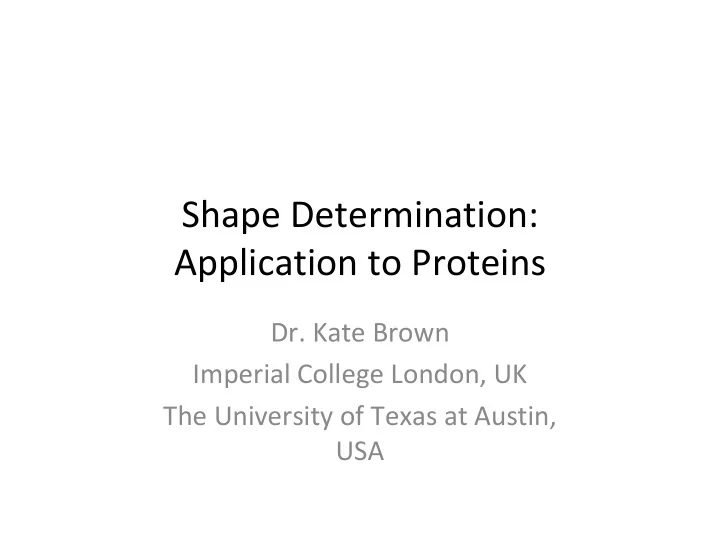

Shape Determination: Application to Proteins Dr. Kate Brown Imperial College London, UK The University of Texas at Austin, USA
Some Reasons for Attempting a Shape Determination of a Protein Using SAXS: Characterization • Rapid method for providing three ‐ dimensional structural information • Means of establishing of oligomerization and/or aggregation state of material • Means to study conformational changes and complexes • A a first step towards developing a more detailed three ‐ dimensional model in solution
Some other Reasons for Determining the Shape of a Protein Using SAXS: Biological and Applications • Enhance fundamental understanding of structure ‐ function relationships • Means to compare or validate conformation with higher resolution information • As a low ‐ or high ‐ throughput method for screening conditions for structural characterization (“pipeline”) • Development of biotherapeutics
Really Understanding the Behaviour of Your Protein as Much as Possible is the KEY to a Successful Shape Determination
Every Protein Has its Own “Personality” In other words, the more you know about your protein and the requirements to make a SAXS SAXS experiment work, the more likely your success. The more you understand about the information you can obtain from SAXS, the more likely you are able to make the most of your limited beamtime.
Top Tips for Successful SAXS Data Collection of Proteins • If you are collecting data at the beamline yourself “in my opinion” you enhance your chances of success by bringing your protein in a very dilute state. This means in conditions which it your protein is stable for the period you will prepare it until you measure it. Do some tests at HOME!! Then concentrate and measure at the beamline. • If you are sending in your samples remotely then do the same, taking into account the concentrations you will provide, how they will be stored (frozen and then thawed for example) – provide as much detail as possible for the beamline scientists.
Be prepared: Information • Have your “exact” sequence and the predicted molecular mass available in a file for each sample. • Attempt to figure out the true concentration of your protein before you do your SAXS experiments. An EXPASY calculated extinction coefficient is often very poor. If you have the time then consider determining a true extinction coefficient. Otherwise use BCA. Be skeptical of the nanodrop – at least have a calculated extinction coefficient with you. For proteins without aromatic residues
Be Prepared: Concentration • Concentration – Remember that calculated extinction coefficients are applicable (in most cases) to unfolded proteins – Depending upon the nature of your studies, you may want to experimentally determine an extinction coefficient using composition analysis [NOTE: for SRCD composition analysis samples is a more standard method for providing a concentration measurement]
Be prepared: Monodisperse Samples • Relatively easy to use laboratory indicators: – Pure protein on standard SDS ‐ PAGE (free of contaminants) – Single species on Native gels – Single symmetric peak from GF/SE chromatography and/or peaks can be isolated and do not re ‐ equilibrate to multiple forms rapidly – Soluble (no precipitate; OD) – Can be concentrated without significant loss of protein – Dynamic Light Scattering (DLS) sometimes but not always reliable • Other methods: mass spectrometry, analytical ultracentrifugation (AUC), SEC ‐ MALLS, etc.
Complexes • The same criteria “sort of” for complexes applied to looking at single component species • Complexes can be polydisperse – in general this is okay when you have SAXS info on the individual components • Data from other complementary techniques used to study protein ‐ ligand or protein ‐ protein complexes can be used to help optimize conditions for SAXS data collection • Be aware that conformational heterogeneity can affect interpretation of your data
Be Prepared: Buffers • Take advice about what buffers are most compatible for SAXS • For Proteins PBS and/or HBS are okay as are a number of other buffers • Pay attention to other components – salts, additives, small molecules, etc. • Detergents are okay if below CMC • Pre ‐ test conditions in lab ahead of time for aggregation if possible • Bring plenty of perfectly matched buffer
At the beamline • Make your standard (BSA in Hamburg) and measure it. Not only will you obtain the information you need for assessing the mass of your sample but you gain familiarity with the system • Spend time understanding how sample loading and measuring works and also what to do if you make an error • Consider sample recovery – post analysis of material can be useful if you have problems • Remember to add fresh DTT (thawed from aliquots) to your samples AND buffer just prior to loading – it is effective but oxidizes over time
At the Beamline: My Sample is Aggregated! • Centrifuge but try to keep the sample cold! • Filter (in my opinion this rarely works) • Dilute and spin • Run on a GF/SEC column • Exchange buffer, shift pH, add salts (sparingly); this can be done in a concentrator but desalting columns are nice – this is a good reason to bring excess material if you can • Add more DTT if radiation damage is a problem • Recover exposed samples and compare with unexposed sample
Recommend
More recommend